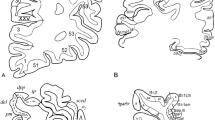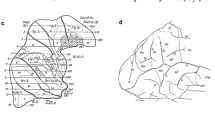Abstract
The comprehensive research programme of the Vogt–Vogt (V–V) school, which was active during the period 1900–1970, included detailed cytoarchitectonic and myeloarchitectonic analyses of the human cerebral cortex, with the aim to integrate the data obtained into a map, showing a parcellation of the human cerebral cortex into fundamental structural and potentially functional units. The cytoarchitectonic V–V analyses yielded two maps of the human cerebral cortex, the famous map of Brodmann (Vergleichende Lokalisationslehre der Grosshirnrinde in ihren Prinzipien dargestellt auf Grund des Zellenbaues. Barth, Leipzig, 1909), Brodmann (in: Bruns P (ed) Neue deutsche Chirurgie, Enke, Stuttgart, 1914), and the less known, but more detailed map of Sarkisov et al. (Cytoarchitecture of the human cortex cerebri. Medgiz, Moscow, 1949). Sarkisov et al. used in their cytoarchitectonic parcellation of the cortex the same numbering scheme as Brodmann. They confirmed the presence of most of the areas delineated by the latter, but they subdivided several of these areas into two or more separate areas or subareas. Within the realm of the myeloarchitectonic V–V analyses, numerous meticulous studies of the cortex of individual cerebral lobes were carried out, but these were not united into a single map. Consequently, the envisioned integration of cytoarchitectonic and myeloarchitectonic data mentioned above was never realized. Some years ago, we (Nieuwenhuys et al. in Brain Struct Funct 220:2551–2573, 2015a, Nieuwenhuys et al. in Brain Struct Funct 220:3753–3755, 2015b) reanalyzed the V–V myeloarchitectonic data, and succeeded in constructing a complete myeloarchitectonic map of the human neocortex from these data. Because the data provided by the V–V school were derived from many different brains, a standard brain had to be introduced as a template to which all data available could be transferred. As such the MNI305 template was selected. Having made available now the cytoarchitectonic maps of Brodmann and Sarkisov et al. and the recently prepared myeloarchitectonic map, an attempt is made here to realize at last the original aim of the V–V school, viz. the preparation of a single, combined (cyto + myelo) architectonic map of the human cortex. To this end, the following three steps have been made. First, Brodmann’s (BR) map, and the map of Sarkisov et al. (SA) were harmoniously transferred to the same template brain as the one used during the construction of our myeloarchitectonic map. Second, the standardized BR and our myeloarchitectonic (NI) map were compared, and the data contained within these maps were integrated into a single standardized combined BR–NI map (Fig. 11). The standardized SA and NI maps were subjected to the same procedure (Fig. 12). Finally, the standardized combined BR–NI and SA–NI maps were united into a single combined BR–SA–NI map (Fig. 13). This map renders it possible to make direct comparisons between the results of the architectonic studies of the V–V school and current parcellations of the human neocortex.














Similar content being viewed by others
References
Amunts K, Zilles K (2015) Architectonic mapping of the human brain beyond Brodmann. Neuron 88:1086–1107
Amunts K, Schleicher A, Zilles K (2007) Cytoarchitecture of the cerebral cortex—more than localization. Neuroimage 37:1061–1065
Braak H (1980) Architectonics of the human telencephalic cortex. Springer, Berlin
Brockhaus H (1940) Die Cyto- und Myeloarchitektonik des Cortex claustralis und des Claustrum beim Menschen. J Psychol Neurol 49:249–348
Brodmann K (1908) Beiträge zur histologischen Lokalisation der Grosshirnrinde. VI. Mitteilung: die Cortexgliederung des Menschen. J Psychol Neurol 10:231–246
Brodmann K (1909) Vergleichende Lokalisationslehre der Grosshirnrinde in ihren Prinzipien dargestellt auf Grund des Zellenbaues. Barth, Leipzig
Brodmann K (1914) Physiologie des Gehirns. Die anatomische Feldertopographie der Grosshirnoberflache. In: Von Bruns P (ed) Neue deutsche Chirurgie. Enke, Stuttgart, pp 85–426
Filimonoff IN (1932) Über die Variabilität der Grosshirnrindenstruktur. Mitteilung II. Regio occipitalis beim erwachsenen Menschen. J Psychol Neurol 44:1–96
Garey LJ (2006) Brodmann's: localisation in the cerebral cortex. Springer Science and Business Media, New York
Gerhardt E (1940) Die Cytoarchitektonik des Isocortex parietalis beim Menschen. J Psychol Neurol 49:367–419
Glasser MF, Coalson TS, Robinson EC, Hacker CD, Harwell J, Yacoub E, Ugurbil K, Andersson J, Beckmann CF, Jenkinson M, Smith SM, Van Essen DC (2016a) A multi-modal parcellation of human cerebral cortex. Nature 536:171–178
Glasser MF, Smith SM, Marcus DS, Andersson JLR, Auerbach EJ, Behrens TEJ, Coalson TS, Harms MP, Jenkinson M, Moeller S, Robinson EC, Sotiropoulos SN, Xu J, Yacoub E, Ugurbil K, Van Essen DC (2016b) The human connectome project's neuroimaging approach. Nat Neurosci 19:1175–1187
Hopf A (1954) Die Myeloarchitektonik des Isocortex temporalis beim Menschen. J Hirnforsch 1:208–279
Hopf A (1955) Über die Verteilung myeloarchitektonischer Merkmale in der isokortikalen Schläfenlappenrinde beim Menschen. J Hirnforsch 2:36–54
Hopf A (1956) Über die Verteilung myeloarchitektonischer Merkmale in der Stirnhirnrinde beim Menschen. J Hirnforsch 2:311–333
Hopf A (1968a) Photometric studies on the myeloarchitecture of the human temporal lobe. J Hirnforsch 10:285–297
Hopf A (1968b) Registration of the myeloarchitecture of the human frontal lobe with an extinction method. J Hirnforsch 10:259–269
Hopf A (1969) Photometric studies on the myeloarchitecture of the human parietal lobe. I Parietal region. J Hirnforsch 11:253–265
Hopf A (1970) Photometric studies on the myeloarchitecture of the human parietal lobe. II Postcentral region. J Hirnforsch 12:135–141
Kononova EP (1935) Structural variability of the cortex cerebri. Inferior frontal gyrus in adults. Ann Brain Res Inst 1:49–118
Lungwitz W (1937) Zur myeloarchitektonischen Untergliederung der menschlichen Area praeoccipitalis (Area 19 Brodmann). J Psychol Neurol 47:607–638
Morosan P, Rademacher J, Schleicher A, Amunts K, Schormann T, Zilles K (2001) Human primary auditory cortex: cytoarchitectonic subdivisions and mapping into a spatial reference system. Neuroimage 13:684–701
Nieuwenhuys R (2013) The myeloarchitectonic studies on the human cerebral cortex of the Vogt-Vogt school, and their significance for the interpretation of functional neuroimaging data. Brain Struct Funct 218:303–352
Nieuwenhuys R, Broere CAJ (2017) A map of the human neocortex showing the estimated overall myelin content of the individual architectonic areas based on the studies of Adolf Hopf. Brain Struct Funct 222:465–480
Nieuwenhuys R, Broere CAJ, Cerliani L (2015a) A new myeloarchitectonic map of the human neocortex based on data from the Vogt-Vogt school. Brain Struct Funct 220:2551–2573
Nieuwenhuys R, Broere CAJ, Cerliani L (2015b) Erratum to: a new myeloarchitectonic map of the human neocortex based on data from the Vogt-Vogt school. Brain Struct Funct 220:3753–3755
Öngür D, Ferry AT, Price JL (2003) Architectonic subdivision of the human orbital and medial prefrontal cortex. J Comp Neurol 460:425–449
Palomero-Gallagher N, Zilles K (2018) Cyto- and receptor architectonic mapping of the human brain. In: Huitinga I, Webster MJ (eds) Handbook of clinical neurology, vol 150, chap 24. Elsevier, Amsterdam, pp 355–387
Rajkowska G, Goldman-Rakic PS (1995a) Cytoarchitectonic definition of prefrontal areas in the normal human cortex: I. Remapping of areas 9 and 46 using quantitative criteria. Cereb Cortex 5:307–322
Rajkowska G, Goldman-Rakic PS (1995b) Cytoarchitectonic definition of prefrontal areas in the normal human cortex: II. Variability in locations of areas 9 and 46 and relationship to the Talairach Coordinate System. Cereb Cortex 5:323–337
Richter J (2007) Pantheon of Brains: the Moscow Brain Research Institute 1925–1936. J Hist Neurosci 16:138–149
Roland PE, Zilles K (1998) Structural divisions and functional fields in the human cerebral cortex. Brain Res Rev 26:87–105
Sanides F (1962) Die Architektonik des menschlichen Stirnhirns. In: Müller M, Spatz H, Vogel P (eds) Monographien aus dem Gesamtgebiete der Neurologie und Psychiatrie, vol 98. Springer, Berlin
Sanides F (1964) The cyto-myeloarchitecture of the human frontal lobe and its relation to phylogenetic differentiation of the cerebral cortex. J Hirnforsch 7:269–282
Sarkisov SA, Filimonoff IN, Preobrazhenskaya IS (1949) Cytoarchitecture of the human cortex cerebri. Medgiz, Moscow
Sarkisov SA, Filimonoff IN, Kononova EP, Preobrazhenskaya IS, Kukuew LA (1955) Atlas of the Cytoarchitectonics of the Human Cerebral Cortex. Medgiz, Moscow
Sporns O (2011) The human connectome: a complex network. Ann NY Acad Sci 1224:109–125
Sporns O, Tononi G, Kötter R (2005) The human connectome: a structural description of the human brain. PLoS Comput Biol 1:e42
Strasburger EH (1937) Die myeloarchitektonische Gliederung des Stirnhirns beim Menschen und Schimpansen. J Psychol Neurol 47:460–491
Strasburger EH (1938) Vergleichende myeloarchitektonische Studien an der erweiterten Brocaschen Region des Menschen. J Psychol Neurol 48:477–511
Uylings HBM, Rajkowska G, Sanz-Arigita E, Amunts K, Zilles K (2005) Consequences of large interindividual variability for human brain atlases: converging macroscopical imaging and microscopical neuroanatomy. Anat Embryol 210:423–431
Vogt O (1903) Zur anatomischen Gliederung des Cortex cerebri. J Psychol Neurol 2:160–180
Vogt O (1910) Die myeloarchitektonische Felderung des menschlichen Stirnhirns. J Psychol Neurol 15:221–232
Vogt O (1911) Die Myeloarchitektonik des Isocortex parietalis. J Psychol Neurol 18:379–390
Vogt C, Vogt O (1919) Allgemeine Ergebnisse unserer Hirnforschung. J Psychol Neurol 25:279–468
Vogt C, Vogt O (1953) Gestaltung der topistischen Hirnforschung und ihre Förderung durch den Hirnbau und seine Anomalien. J Hirnforsch 1:1–46
Vogt C, Vogt O (1956) Weitere Ausführungen zum Arbeitsprogramm des Hirnforschungsinstitutes in Neustadt/Schwarzwald. J Hirnforsch 2:403–427
Zilles K, Amunts K (2009) Receptor mapping: architecture of the human cerebral cortex. Curr Opin Neurol 22:331–339
Acknowledgements
The authors thank Prof. Lawrence Bannister for critically reading the manuscript, Mr Ton Put for preparing the illustrations, Dr Jenneke Kruisbrink for help with the collection of literature, and Suzannne Bakker M.Sc. for moral support and reference management.
Author information
Authors and Affiliations
Corresponding author
Additional information
This article is dedicated to the memory of Prof. Dr. Karl Zilles, an outstanding neuroanatomist, who was for us a great inspirator and a good friend.
Publisher's Note
Springer Nature remains neutral with regard to jurisdictional claims in published maps and institutional affiliations.
Rights and permissions
About this article
Cite this article
Nieuwenhuys, R., Broere, C.A.J. A detailed comparison of the cytoarchitectonic and myeloarchitectonic maps of the human neocortex produced by the Vogt–Vogt school. Brain Struct Funct 225, 2717–2733 (2020). https://doi.org/10.1007/s00429-020-02150-2
Received:
Accepted:
Published:
Issue Date:
DOI: https://doi.org/10.1007/s00429-020-02150-2




